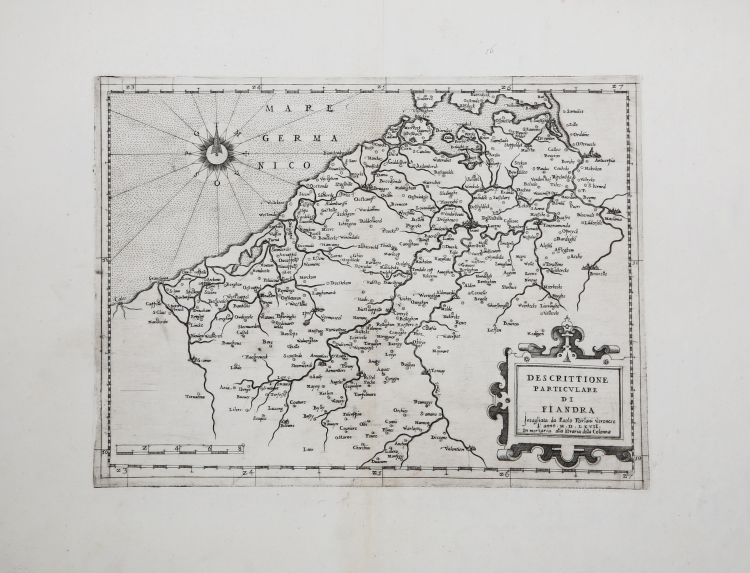




| Reference: | S30335 |
| Author | Paolo FORLANI |
| Year: | 1567 |
| Zone: | Belgium |
| Printed: | Venice |
| Measures: | 355 x 265 mm |



| Reference: | S30335 |
| Author | Paolo FORLANI |
| Year: | 1567 |
| Zone: | Belgium |
| Printed: | Venice |
| Measures: | 355 x 265 mm |
The cartouche in the lower right corner contains the title and editorial details: DESCRITTIONE PARTICULARE DI FIANDRA. Jntagliata da Paolo Forlani Veronese l’anno M.D.LXVII. In merzaria alla libreria della Colonna. Bottom left shows graphic scale, with division but no units (8, equal to mm 78). Orientation with a rose of eight winds in the sea (Mistral and Libeccio are reversed with Grecale and Sirocco), north is at the top. Graduation at the margins of 1' in 1', from 49° 55' to 51° 52' latitude and 6' in 6', from 22° 47' to 26° 54' longitude.
Venetian derivation of the Vlanderen. Exactissima Flandriae Descriptio (1540) by Gerard Mercator, already taken in Venice from the maps of Giovanni Andrea Vavassore (1556), Domenico Zenoi and Giovanni Francesco Camocio. Paolo Forlani's map of Flanders, however, bears several similarities to the map published in the first edition of Lodovico Guicciardini's Descrittione de tutti i Paesi Bassi, published in Antwerp in 1567. It is a rather rough product and is an example of the incredible speed of information transfer among map producers of the time.
Paolo Forlani, a native of Verona, opened his own chalcographic workshop in Venice, Al segno del pozzo, in 1560, as reflected in some of his works. From 1566 he was active in Merzaria al segno della colonna and from 1569 in Merzaria al segno della nave. Forlani had business relationships with the major publishers of cartographic material of the time, among them Antonio Lafreri, the Bertelli family, and others. In addition to being a talented engraver, he was also quick to execute, a quality that enabled him to work for different publishers at the same time, and to execute a large amount of work. Woodward attributes about one hundred works to Forlani, most of which, however, are unsigned. Between 1560 and 1567, Forlani collaborated with Ferrando Bertelli, for whom he engraved about ten copperplates, with Camocio, Bolognino Zaltieri, and with Claudio Duchetti, for whom he engraved some maps. For his professional activity, however, the collaboration with Giacomo Gastaldi, for whom he engraved thirteen maps, was very important and valuable. In 1567 Forlani published and traded his work Il primo libro delle città et fortezze principali del mondo, whose branches later passed to Bolognino Zaltieri. It is likely that Forlani died during the plague that spread through Venice from 1575.
Etching and engraving, impressed on contemporary laid paper with “siren in the circle” watermark (Woodward nos. 88-90, notes its presence in the specimen of this same map preserved at Newberry Library), with margins, slight abrasions on verso, otherwise in perfect condition.
Bibliografia
Bifolco-Ronca, Cartografia e topografia italiana del XVI secolo, p. 814, Tav. 288; Almagià, Monumenta Cartografica Vaticana, 1948, p. 61; De Ghein (1994): n. 22; Van der Heijden (1998): p. 36 e tav. 43; Meurer, The Strabo Illustratus Atlas, 15; Karrow (1993): n.56/6.7; Tooley (1939): n. 203; Woodward (1990): n. 67; Woodward (1992): n. 48.
Paolo FORLANI (Attivo a Venezia seconda metà del XVI secolo)
|
Paolo Forlani, a native of Verona, opened his own chalcographic workshop in Venice, Al segno del pozzo, in 1560, as reflected in some of his works. From 1566 he was active in Merzaria al segno della colonna and from 1569 in Merzaria al segno della nave. Forlani had business relationships with the major publishers of cartographic material of the time, among them Antonio Lafreri, the Bertelli family, and others. In addition to being a talented engraver, he was also quick to execute, a quality that enabled him to work for different publishers at the same time, and to execute a large amount of work. Woodward attributes about one hundred works to Forlani, most of which, however, are unsigned. Between 1560 and 1567, Forlani collaborated with Ferrando Bertelli, for whom he engraved about ten copperplates, with Camocio, Bolognino Zaltieri, and with Claudio Duchetti, for whom he engraved some maps. For his professional activity, however, the collaboration with Giacomo Gastaldi, for whom he engraved thirteen maps, was very important and valuable. In 1567 Forlani published and traded his work Il primo libro delle città et fortezze principali del mondo, whose branches later passed to Bolognino Zaltieri. It is likely that Forlani died during the plague that spread through Venice from 1575.
|
Paolo FORLANI (Attivo a Venezia seconda metà del XVI secolo)
|
Paolo Forlani, a native of Verona, opened his own chalcographic workshop in Venice, Al segno del pozzo, in 1560, as reflected in some of his works. From 1566 he was active in Merzaria al segno della colonna and from 1569 in Merzaria al segno della nave. Forlani had business relationships with the major publishers of cartographic material of the time, among them Antonio Lafreri, the Bertelli family, and others. In addition to being a talented engraver, he was also quick to execute, a quality that enabled him to work for different publishers at the same time, and to execute a large amount of work. Woodward attributes about one hundred works to Forlani, most of which, however, are unsigned. Between 1560 and 1567, Forlani collaborated with Ferrando Bertelli, for whom he engraved about ten copperplates, with Camocio, Bolognino Zaltieri, and with Claudio Duchetti, for whom he engraved some maps. For his professional activity, however, the collaboration with Giacomo Gastaldi, for whom he engraved thirteen maps, was very important and valuable. In 1567 Forlani published and traded his work Il primo libro delle città et fortezze principali del mondo, whose branches later passed to Bolognino Zaltieri. It is likely that Forlani died during the plague that spread through Venice from 1575.
|